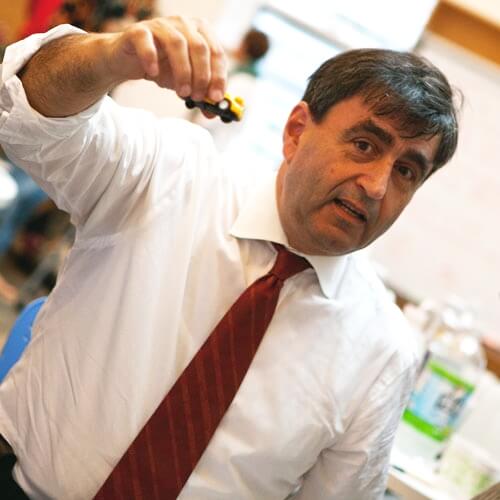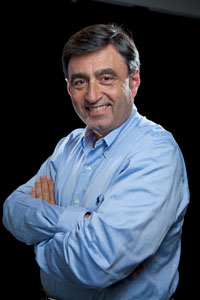News
Eric Mazur has flipped the classroom, abandoning traditional lectures and favoring hands-on, team-based activities. (Photo by Eliza Grinnell, SEAS Communications.)
Eric Mazur (seated at center) engages a group of students in AP 50, an introductory applied physics course, asking them to explain in detail the roles of kinetic and potential energy in the Rube Goldberg machine they have built. (Photo by Eliza Grinnell, SEAS Communications.)
“Assessment,” says Eric Mazur, “is the silent killer of educational innovation.”
That would be a bold statement for anyone but Mazur, Balkanski Professor of Physics and Applied Physics at Harvard, and Area Dean for Applied Physics at the Harvard School of Engineering and Applied Sciences (SEAS).
Famous worldwide for developing Peer Instruction, a question-based active learning method, Mazur has been teaching introductory physics and applied physics courses at Harvard for three decades—and challenging the status quo for just as long.
His pedagogical accomplishments most recently earned him the 2013 HETL Award for Lifetime Achievement in Teaching and Learning. And in April this year, the American Physiological Society invited him to give its annual Claude Bernard Distinguished Lecture. Ironically, his talk was titled “Confessions of a Converted Lecturer.”
Mazur began to make waves in 1993 when he gave a talk of a similar name, promoting the philosophy of the “flipped classroom”—put simply, the idea that the teacher’s role is not to lecture from a book, but to challenge students with conceptual problems. Mazur’s 1997 book Peer Instruction: A User’s Manual, developed with the support of the National Science Foundation and the Pew Charitable Trust, has been translated into four languages, with over 26,000 copies distributed.
“Eric’s innovative thinking has been disruptive in the best sense of the word,” says Cherry A. Murray, Dean of Harvard SEAS. “He has used a scientist’s mindset to formulate and perfect a new approach to teaching that complements what we already know about how students learn. That's catching on internationally because it prepares graduates to engage with difficult problems beyond the classroom walls."
It’s not that traditional teaching methods were wrong, Mazur says. Rather, what students need to learn these days requires something different.
“We’re emerging from an era where information was mostly static, only slowly evolving—curated by libraries and by universities and accessible only in limited venues—to an era where information is continually evolving, rapidly changing, and accessible around the clock,” Mazur says, over Skype from a conference in Florida. “I think that that transformation is going to have an absolutely phenomenal impact on education and, more importantly, it’s going to have an impact on the skills that are required.”
Just as machines have made assembly-line jobs obsolete, Mazur predicts, jobs involving information retrieval and procedural problem solving may also soon be gone. And most would agree that higher education should supply the workforce with graduates who, at a minimum, can’t be replaced by robots.
But it’s not just about the economy, of course; it’s about truly cultivating the mind of the student. To do so, Mazur says, “We must rethink our approach to education and start to focus more on what I would call authentic problem solving and on stimulating creativity and innovation.”
The traditional education system, as Mazur sees it, typically evaluates students’ work by marking their responses as correct or incorrect. But that system of assessment is poorly suited for a course where the intended educational outcomes include skills like design or critical thinking.
“One of the hallmarks of creativity and innovation is that the road is littered with failures,” Mazur explains. “Even the best artist will have to try something, backtrack, and try it again until he or she hits something that is worthwhile. You have to be comfortable with failing.”
“The traditional approach to testing is completely incompatible with that,” Mazur adds. “Students become afraid of making mistakes and losing points.”
In a classroom based on Peer Instruction, that strict grading rubric is replaced most days by small groups of classmates, actively discussing a problem and reacting to one another.
“Peer Instruction emphasizes formative assessment where students can just give an answer and try out their knowledge, without being penalized for it,” Mazur says. “They become more comfortable with sticking out their necks and trying something out.”
The hard part of learning, after all, isn’t the reading and memorization; it’s the part where someone challenges you with an unexpected question. It’s the part where you have to assimilate new information with what you already think you know, and the misconceptions you don’t realize you’re carrying.
“That’s what we really should be focusing on,” says Mazur. “Throw information transfer out of the classroom. Have the students do the homework before class—read a book, watch a video lecture, or go out and collect data—and then in class we’ll work on really understanding the information, questioning it, and using it.”
Consider an all-too-common scenario in a lecture hall. The instructor spends 20 minutes explaining force and momentum, before pausing to ask, “Does that all make sense?” The class is silent, so the instructor moves on to the next topic.
Engagement and assessment are missing. That can be fixed, in part, by technology.
With Brian Lukoff (a postdoctoral fellow in teaching and education at SEAS) and Gary King (Albert J. Weatherhead III University Professor in the Department of Government), Mazur developed a web-based system called Learning Catalytics that improves the quality of communication in the classroom and computationally analyzes the interactions on the spot. The system poses a challenging question, collects students’ responses in class, and provides instant feedback to both the students and the instructor about what’s working and what’s not. Suppose 60 percent of the class has memorized the definitions of force and momentum, but can’t quite see why colliding objects would keep moving. The system quickly identifies the 40 percent who do understand, and reassigns the students to mixed groups to encourage fruitful conversations.
Meanwhile, the instructor can more effectively spend his or her time identifying and addressing students’ misconceptions.
Following several years’ work on the system, classroom testing, and “board meetings” held while bicycling through the woods of Concord, Mass., Mazur, Lukoff, and King recently sold Learning Catalytics to the international education company Pearson.
“Many people pass standardized tests and still fail in the real world—and vice versa,” says Mazur. “If we don’t change assessment, education will never change.”
Meanwhile, Peer Instruction continues to ‘convert’ lecturers around the world.
Last year, Mazur received an honorary professorship at Beijing Normal University (BNU), an institution known for its strong teacher training programs in secondary and post-secondary education.
Teaming up with faculty at BNU, Mazur co-chaired a committee to organize the First International Asia-Pacific Conference on Peer Instruction in December 2012. Spurred by the translation of his book into Chinese, and originally intended for academics in the Pacific Rim, the conference ended up drawing more than 200 attendees from five continents.
The next conference will take place in Europe—Switzerland 2014.
“It’s so gratifying to see that we’re building a community out there, and to see that there is an interest in Peer Instruction that’s expanding far beyond our initial audience,” says Mazur. “It’s like a snowball that’s started rolling. I never thought I'd write a book about PI, or talk about it at conferences, or get awards for it. I just did it because I had a problem to solve in my class.”
Topics: Applied Physics, Academics
Cutting-edge science delivered direct to your inbox.
Join the Harvard SEAS mailing list.
Scientist Profiles
Eric Mazur
Balkanski Professor of Physics and Applied Physics




